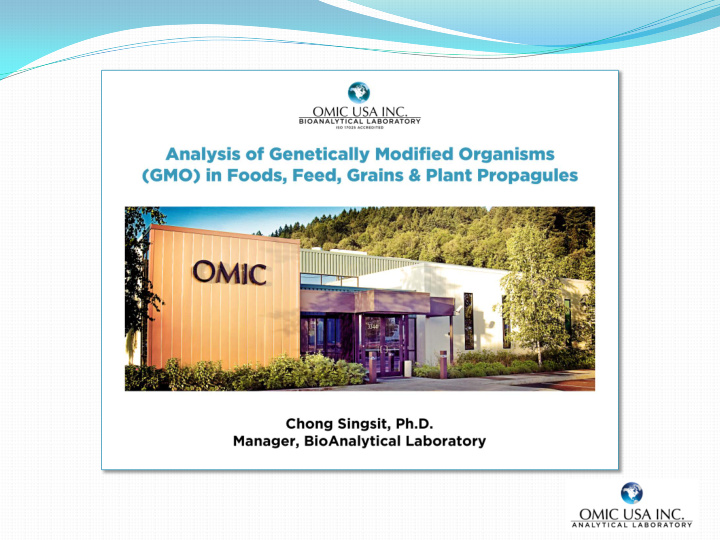



OMIC USA OFFERINGS
5% 5% 3% Open (0.9% or 3% or 5%) 0.9% 5% THRESHOLD FOR APPROVED GM TRAITS Japan: Taiwan: Korea: China: EU: U.S. & Canada:
PROCESS INVOLVED IN MAKING GMO PLANTS / CRITERIA Gene discovery Transformation (insertion of novel genes) Good selectable markers Characterization of inserted genes Gene expression analysis Field evaluation and selection Regulatory submission and approval Commercial launch and marketing of new variety
SAMPLE LOG IN Inspect, input, and assign a unique number for tracking SAMPLE PREPARATION Sub-sampling, grinding, homogenization, and DNA sample collection STEPS IN GMO TESTING
DNA / PROTEIN EXTRACTION Extract, purify, quantitate, and standardize DNA AMPLIFICATION BY PCR Prepare master mix, PCR plate, and run ANALYSIS OF RESULTS AND REPORTING Review criteria: R², % recovery, slope, efficiency STEPS IN GMO TESTING
DNA-GMO DEPARTMENT sample between samples QUALITY CONTROL OPERATIONS NEW TECHNOLOGY & NEW TECHNOLOGY OLD TECHNOLOGY the emission of dust positive and negative air preventing contamination that might otherwise compromise the lab's sensitive instruments. SAMPLE PREPARATION controlled rooms with grinding pressure environments, thus LABORATORY FACILITIES • Specifically designed and • Instrument totally clean • The ZM200 Cyclone minimizes • Sub-sampling, weighing, and • Application of statistical tools • Collection of representative
Variation (CV) of replicate DNA ≤ 3% Pipette tips for repetitive use should not PROCESS OF DNA EXTRACTION (tubes) Maintain a safe distance between samples VALIDATION OF DNA QUALITY CONTROL Precipitation and elution of DNA The use of filtered pipette tips Qubit Fluorometer (DNA-specific dye) Membrane purification of DNA Fluorescence excitation / emission Pre-purification of DNA The method measures dsDNA against Incubation of DNA samples and cellular lyses λDNA touch the tube DNA EXTRACTION • • • • • • • • • • • •
REAL-TIME TAQMAN PCR
the slope and the intercept QUANTITATIVE PCR Calculation of % GMO based on of traces Amplification and quantification 1.0%, 5.0%, and 10.0%) five levels of matrix (0.05%, 0.1%, Standard curves generated using Quantitative: absolute or relative Limit of quantification (LOQ) 0.1% Limit of detection (LOD) 0.01% TaqMan probes Performed in real-time PCR REAL-TIME TAQMAN PCR • • • • • • • •
RT-PCR products Sizing reproducibility: 5% CV (for QUALITATIVE ASSAY USING PCR & AGILENT 2100 BIOANALYZER Used in the analysis of PCR and Chips and reagents designed for sizing and analysis of DNA fragments (for ladder as sample) Sizing range: 25-1,000 bp Quantitation accuracy: 20% CV ladder as sample) as sample) QUALITATIVE DNA ANALYSIS WITH AGILENT 2100 BIOANALYZER • • • Sizing accuracy: ± 10% (for ladder • • •
REPEATABILITY OF A METHOD Comparing the two outcomes Different person and different date Same method Testing the precisions under reproducible conditions REPRODUCIBILITY OF A METHOD Application of formula Analysis of calculation of the outcome Testing repeatability conditions Same method Testing the precisions under intra-lab conditions QUALITY CONTROL
ACCURACY (TRUENESS AND PRECISION) QUALITY CONTROL PCR Corn spike level 0.3% (0.10% RSD; 0.10 bias; 0.076 MU) Corn spike level 0.1% (17.9% RSD; 0.006 bias; 0.046 MU) PCR PCR QUALITY CONTROL Close to the true value and high precision The process is carried out in duplicate Extraction Positive control Extraction Negative control Extraction Measurement Uncertainty
APPLICABILITY Scope of the Method should be broad specific Within 25% of the accepted reference value TRUENESS Less than 1/20 of the target concentration LOD Less than 1/10 of the value of the target concentration LOQ Below 25% over the whole range RSDR -3.0 ≥ slope ≥ 3.6 PCR EFFICIENCY ≥ 0.96 R-SQUARE Availability of equipment, practical hindrances PRACTICALITY ACCURACY Event-specific or marker-specific SPECIFICITY ACCEPTANCE CRITERIA & PERFORMANCE REQUIREMENTS Within the limit of ± 25% interference value
CHALLENGES IN PCR DETECTION TARGET MOLECULES Degraded or absent molecule undetectable Significant effects of processing CAPTURE MOLECULES MUST BE DEVELOPED Impossible without description of target molecules CERTIFIED REFERENCE MATERIALS The difficulty to obtain CRMs GENE STACKING
corn, soy, rice PARTICIPATION IN PROFICIENCY PROGRAMS USDA / GIPSA Twice a year covering seven traits and six samples for a total of 42 tests; FAPAS Europe Twice a year; selective traits Canadian Grain Commission Twice a year; flax DOW AgroSciences Once every two years; two corn traits Bayer CropScience Once every two years; two soybean traits)
Validation is the confirmation by examination and the provision of objective evidence that validation process Completion of the the method Optimization of new method Development of a Acceptance Criteria (Pre-validation Requirements) Performance Requirements the particular requirements for a specific intended use are fulfilled. It is a process and not a THE VALIDATION PROCESS: How do we validate the analytical method? By performing an in-house validation. The purpose of validation is to check whether the method is fit for the purpose. result. METHOD VALIDATION PROCESS FOR SPECIFIC GMO EVENTS
GENERAL LIMIT OF DETECTION LIMIT OF QUANTIFICATION MOLECULAR SPECIFICITY VALIDATION OF NEW METHODS Experimental Design Optimize DNA The Lowest detection Limit Soybean 0.05% in 100ng of total DNA Is 0.1% in 100ng of total soybean DNA Based on target DNA over total DNA Screen the primers /probe for specificity The test of homology
CALIBRATION CURVE / STANDARD CURVE calibration points DATA ANALYSIS CALCULATION VALIDATION OF NEW METHODS Five Spike Levels Using Target DNA to Generate a Calibration Curve Produced by plotting the Ct values against the log of target copy no for the Set the threshold and the baseline crosses the first amplification curve Save the settings Use this formula if plasmid DNA is used to generate a standard curve GM % = {target (copy #)/endo copy #*100}
Maize Analysis Scheme Double Screen 35S promoter and/or NOS terminator positive Repeat Double Screen Negative with new DNA-Extraction 35S + NOS - 35S + NOS + 35S - NOS + Identification: Identification: Identification: -Event MON810 -Bt11 -GA21 -Bt 176 -NK603 -MIR604 -event Herculex -MON863 -Herculex RW -MON88017 -event T25 -nptII Positive Negative Quantification of each positive event Certificate of Analysis
Thank you.
Recommend
More recommend